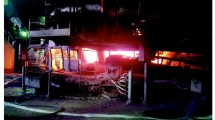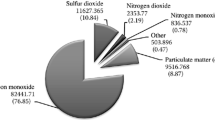Conclusions
Conditioning the flue gas with ammonia reduces the SEE of the dust so that the degree of dust entrapment in electrical precipitators increases, more especially when the flue gas contains a large proportion of sulfur oxides.
Conditioning is at optimum with a 3–6% ammonia solution and an ammonia consumption of 4–5 kg per 100,000 m3 flue gas.
Similar content being viewed by others
Literature cited
V. N. Uzhov, Scrubbing Industrial Gases with Electrical Precipitators [in Russian], Khimiya. Moscow (1967).
L. G. Chalyi, Trans. All-Union Scientific-Research and Planning Institute for Electrical Purification in Ferrous Metallurgy [in Russian], No. 13, Metallurgiya, Moscow (1970), pp. 38–46.
Author information
Authors and Affiliations
Additional information
Translated from Ogneupory, No. 11, pp. 13–16, November, 1975.
Rights and permissions
About this article
Cite this article
Tseluiko, Y.I., Chander, Y.I. & Borisovskii, L.M. Ammonia added to the gas- and-dust emission of rotary kilns as a factor in the performance of the electrical precipitators. Refractories 16, 676–678 (1975). https://doi.org/10.1007/BF01280600
Issue Date:
DOI: https://doi.org/10.1007/BF01280600




